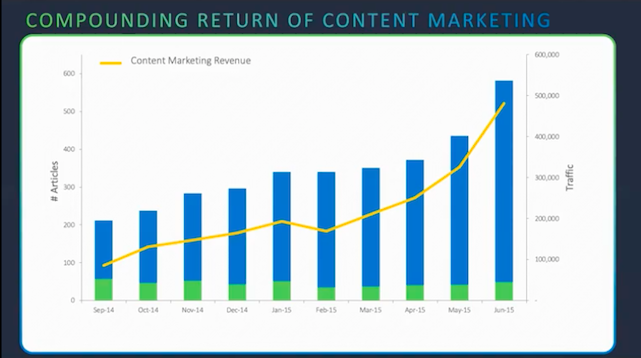Studies Reveal What Traffic Sources Will Bring Us The Highest Profits! So, You Stop Waisting Money!



Introduction
Elon Musk has a concept that he calls the idiot index, where in building a rocket, he takes the component cost and the cost of the materials ($1,000 component, $100 raw material = idiot index of 10 to 1), finding inefficiencies. Or determining if you are an idiot.
SpaceX’s Raptor rockets cost $2,000,000, with the goal of using the idiot index to bring it down to $200,000. However, according to some leaked resources, Elon’s engineers were able to get it down to $250,000.
So many businesses are not spending their money efficiently in their advertising. However, if we apply Elon’s idiot index to traffic, you will see most business owners are inefficient and see which traffic sources pass Elon Musk’s idiot index.
The marketplace is filled with opportunities promising that they can get you the traffic you need; however, not all traffic sources are created equal.
In other words, if you understand the idiot index, you can achieve far greater results than your competition with less effort and resources.
For example, Kyle Handy is a real estate agent who spent $22,000 on Google ads, which brought in $41,324 and a profit of $19,324. So, he brought in a return of almost 87%. However, Tony Kelso invested $50,626 in direct mail that brought in $543,390, just shy of 1,120%.
So, it’s not about buying into the hype but understanding the economics of each advertising model by applying Elon Musk’s idiot index.
So, I asked ChatGPT to use Elon Musk’s “idiot index” in comparing different marketing channels to find the best traffic sources.
As you saw in the case of Kyle Handy and Tony Kelso, it’s not just about making money, because both made money, but what is the most productive money spent.
The productivity of advertising is a combination of a few different factors, including a person’s sales ability. So, even though two companies may be selling the exact same product, using the same traffic source, one may outsell the other because of their personal sales ability. However, ChatGPT did not give me the exact number but ranked each traffic source from high, moderate, low, and then ranked the top 5 based on this research.
So, we did additional research to find what the average business is spending and how much they are earning. Research can be dry at times; however, this is important for you because this data will arm you with knowledge that 99% of other businesses do not have access to. So, let’s dive into this.

Idiot Index: High
Search: The advantage of search-based advertising is that traffic from search engines consists of an audience actively looking to buy, unlike most advertising, which is what is called interruption advertising, such as what happens on social media and TV.
As you watch TV or are browsing the internet you are introduced to different products. This is what is meant by interruption marketing.
- Google AdWords:
- Idiot Index: High
- ROI: Brandcampdigital.com says: On average, Google Ad bring you a return of $2 for every $1 invested.
- Explanation: Google AdWords allows businesses to create and manage pay-per-click (PPC) ads on Google’s search engine and partner networks. While setting up ad campaigns is relatively user-friendly, achieving optimal results requires understanding keyword research, bidding strategies, and ad targeting
- Yahoo/Bing Advertising:
- Idiot Index: High
- Explanation: Advertising on Yahoo and Bing involves similar principles to Google AdWords but may have differences in audience demographics and ad platform functionality.
Advantages: Bing’s average CVR is slightly better than what we see on Google Ads. There are some advantages over Google ads with Bing and Yahoo for some companies, so we advise doing more research to see if Bing and/or Yahoo is right for you.
- Display Ads:
- Idiot Index: High
- ROI: According to Webfx.com, for every $1 invested, display ads bring in a return of $2.
- Explanation: Display advertising involves placing visual ads (banner ads) on websites and mobile apps. While setup and targeting options are relatively simple, achieving high engagement and conversion rates may require experimentation and optimization.
Idiot Index: Moderate To High
- Paid Social Media Ads: There is a lot of hype regarding social media advertising because these channels have massive audiences. However, due to the sheer volume of messages bombarding us, many ads go unnoticed. Chi posted a report in 2023 stating that in 2008, it took someone seeing our ads 5-8 times before remembering us. However, today, with the overwhelming amount of messages on social media, it takes someone seeing our ads 500 times before they remember us.
But on social media, that’s why we are often only charged per click. However, when the economy is good, due to the popularity of social media, the top social media companies raise their prices. According to an article from Business Insider in July 2021, five major social media platforms are showing a dramatic increase in advertising costs year-over-year.
- Google and YouTube’s CPM increased by 108%.
- Facebook ad costs had an 89% increase, while the average CPM was $11.
- TikTok’s CPM went up by 92%.
- Snapchat had “the lowest” increase in CPM at 64%.
According to an article at https://gitnux.org/social-media-marketing-roi-statistics/#:~:text=The%20average%20ROI%20for%20social,media%20conversion%20rate%20was%209.3%25, social media advertising has an average return of $2.50 for every dollar invested. However, this is why skill is important because I personally know people who earn a return of $4.80 for every dollar they spend on social media advertising.
If you have a large advertising budget, social media may give you the traffic you need. However, if you are a smaller company, social media is not the best option for you.
- Facebook Advertising:
- Idiot Index: Moderate to High
- ROI: Social media advertising has an average return of $2.50 for every dollar invested.
- Explanation: Facebook’s advertising platform offers a wide range of targeting options and ad formats, making it powerful but potentially complex for beginners. However, its user-friendly interface and extensive resources make it accessible to marketers of varying skill levels.
- Instagram Advertising:
- Idiot Index: Moderate to High
- ROI: Social media advertising has an average return of $2.50 for every dollar invested.
- Explanation: Instagram’s advertising platform integrates seamlessly with Facebook Ads Manager, offering similar targeting options and ad formats. While visually engaging, understanding Instagram’s audience and optimizing ad performance may require some expertise.
- Twitter Advertising:
- Idiot Index: Moderate to High
- ROI: Social media advertising has an average return of $2.50 for every dollar invested.
- Explanation: Twitter’s advertising platform allows businesses to promote tweets, profiles, and trends to targeted audiences. While the setup is relatively straightforward, achieving success may require experimentation and familiarity with Twitter’s user behavior.
- Pinterest Advertising:
- Idiot Index: Moderate to High
- ROI: Social media advertising has an average return of $2.50 for every dollar invested.
- Explanation: Pinterest’s advertising platform enables businesses to promote pins to users based on interests, keywords, and demographics. While visually-driven and intuitive, maximizing ROI may require understanding Pinterest’s unique audience and content preferences.
- LinkedIn Advertising:
- Idiot Index: Moderate to High
- ROI: Social media advertising has an average return of $2.50 for every dollar invested.
- Explanation: LinkedIn’s advertising platform targets professionals and businesses, offering options for sponsored content, text ads, and sponsored InMail. While targeting options are robust, achieving optimal results may require knowledge of LinkedIn’s professional user behavior.
- YouTube Advertising:
- Idiot Index: Moderate to High
- ROI: Social media advertising has an average return of $2.50 for every dollar invested.
- Explanation: YouTube advertising involves creating and optimizing video ads to reach targeted audiences. While the platform offers extensive reach and targeting options, producing compelling video content and analyzing performance metrics may require expertise.
Idiot Index: Moderate
- Media, Influencer Marketing:
- Idiot Index: Moderate
- ROI: There are reports that show influencer marketing brings an 11x return. However, influencermarketinghub.com suggests this is an overestimation. Nevertheless, influencer marketing still yields better returns than if you had invested the same money into social media.
- Tips: Influencer marketing capitalizes on the relationships influencers have with their following. Similarly to word-of-mouth advertising, it seems to be very effective if you don’t focus on the size of the following but rather the relationship they have with their audience.
- Explanation: Content marketing encompasses various channels and formats, each with its own level of complexity. While creating content is accessible, developing a comprehensive content strategy and measuring effectiveness require expertise.
- Print Advertising (Newspapers, Magazines, Flyers, Postcards):
- Idiot Index: Moderate
- ROI: Magazines deliver a higher ROI on advertising spending across all media, averaging a $3.94 return on every dollar spent. That’s 50% higher than all other categories. Nielsen also looked into this and found magazines had the highest aggregate ROI over TV, online, online video, and outdoor.
- Explanation: Print advertising involves placing ads in traditional print media. While the concept is familiar, achieving effective reach and ROI may require understanding audience demographics and publication circulation.
- Broadcast Advertising (Radio and TV):
- Idiot Index: Moderate
- ROI: TV has a return of 300-500%, or a return of $3-5 for every dollar invested. However, iheartradio says it will bring you a return of $6 for every dollar you invest. TV and radio are out of the price range for many of us. So, if you are considering TV or radio, you should look at local options. There is new technology that makes it easier to target certain viewers, similar to what can be done through the internet.
- Explanation: Broadcast advertising involves airing commercials on radio and television. While reaching mass audiences, creating impactful ads and negotiating media buys may require expertise.
Idiot Index: Low
- SEO (Search Engine Optimization):
- Idiot Index: Low
- Cost: On average, SEO costs range from $100 to $250 per hour for US SEO agencies. Monthly SEO costs typically fall between $2,500 and $10,000 for US agencies, with the average SEO plan costing around $2,819 per month.
- ROI: TeraKeet estimates that the average ROI of SEO ranges from 550% to 1,220%.
- Explanation: SEO involves optimizing website content and structure to improve organic search engine rankings. While the concept is straightforward, implementing effective SEO strategies requires technical knowledge and ongoing monitoring and adjustments.
- Downside: SEO involves analyzing data to find the perfect balance of keywords that receive enough traffic and are not overly competitive. Using overly competitive keywords may lead to a loss of potential profits. It may also take months before you see any results. We suggest setting a budget of at least 12 months to see results.
- Content Marketing (Blogging, Video Marketing, Podcasting, Organic Social Media, Influencer Marketing):
- Idiot Index: Low
- ROI: Sitecore states that across all industries, the average return on investment was 748%, assuming consistent weekly publication. For example, the Cleveland Clinic invested $100,000 for a team to create content that brought in a return of $790,000 in the first year however, overtime because of the amount of content you have out on the internet it continues to drive more and more traffic.

- Explanation: Content marketing encompasses various channels and formats, each with its level of complexity. While creating content is accessible, developing a comprehensive content strategy and measuring effectiveness require expertise.
- Top producing content are:

TOP 5 Highest ROI Traffic Sources
- Direct Mail / FlyersIdiot Index:
- Idiot Index: #5
- ROI: Postpilot, an automated postcard marketing company, reports a return of 400-700%. However, Tony Kelso saw a return of 1,120% by sending out a postcard. He employed a strategy called farming, marketing to the same neighborhoods every 2-4 weeks.
- Explanation: Direct mail involves sending physical promotional materials via postal mail. While conceptually simple, achieving high response rates and ROI may require targeted segmentation and compelling creative.
- Affiliate Marketing:
- Idiot Index: #4
- ROI: AuthorityHacker.com states that brands using affiliate marketing get an average return on investment (ROI) of $15 for every dollar spent, equating to a 1400% return.
- Explanation: Affiliate marketing involves partnering with affiliates to promote products or services in exchange for a commission. While setup is straightforward, managing affiliate relationships and tracking performance may require expertise.
- Cold Calling:
- Idiot Index: #3
- ROI: I couldn’t find online data for the average ROI for cold calling. However, according to marketingcharts.com, cold calling is the best way to generate interested prospects, even beating direct mail, social media, and display ads.
- Cost: Expenses include CRM ($300), numbers to call ($150), and phone bill ($50).
- Tip: Based on my own research, cold calling has an ROI of 3,000%. Over a 6-8 hour period, you can generate 20-30 interested prospects per day and close 10-15 sales a week, generating $18,000 a month at just $300 per sale.
- Explanation: Cold calling involves reaching out to potential customers via phone. While conceptually simple, success depends on communication skills and overcoming objections.
- Cold Emailing:
- Idiot Index: #2
- ROI: Cold emailing has an ROI of $36 for every $1 invested or 3,600%. However, Hubspot claims email has an ROI of 4,400%.
- Cost: Expenses include an autoresponder for sending out thousands of emails, domains for compliance, and a scrapper for finding email addresses to send.
- Explanation: Cold emailing is not spam. It involves reaching out to potential customers via email. While conceptually simple, success depends on communication skills and overcoming objections.
- Joint Ventures:
- Idiot Index: #1
- ROI: Returns can vary, but the first time I used a joint venture, I saw a return of over 7,000%. In other words, I spent $200 and brought in $14,100 in just 6 hours.
- Explanation: Joint ventures involve collaborating with other businesses to mutually market products or services. While conceptually simple, negotiating partnerships and ensuring alignment of goals can be complex, requiring tools such as cold calling, emails, direct mail, or others to find partners.
Conclusion
The numbers you see here represent what the average business is spending on traffic for each platform, but who wants to be average? The real potential of each of these traffic methods lies in developing your selling and marketing skills to achieve better results than what you see in this article.
Paid social media has an ROI of 250%, or $2.50 for every $1 you invest in advertising. However, by introducing multiple products to those same customers over time and selling to them repeatedly, I know contacts who are earning $50 for every $1 they invest in advertising but it will take a while to get you to that point.
The first time I used a joint venture, I had a return of 7,000%. The next time I used joint ventures, I made a deal with Al Nin, where we landed a deal with his dentist. We provided them with marketing material, and in the first 90 days, that generated 3,200 new patients at an average of $2,000 per patient for a total of $6.5 million dollars over the next 12 months.
I am not sure what was invested into this project; however, it is somewhere in the range of a return of 65,000%.
Joint Ventures come in at #1 as the most profitable form of advertising, but then we combine them with cold calling, email, social media, and other tools to get our message out to our audiences.
Bill Gates made nearly $10 million dollars from his first joint venture. Today, 90% of Microsoft’s revenue comes from joint ventures. Quest Nutrition sent letters with product samples to a bunch of social media influencers, who then began talking about their products to their social media audiences, and over 3 that took Quest Nutrition to a billion dollars.
What kind of ROI do you believe they experienced?
People love the idea of using joint ventures, which essentially is instead of paying for advertising, which unless you have seen the research won’t bring you the returns you need, with joint ventures you use someone else’s following to build your customer base. But going from idea to putting this into action is too much for so many of you because you may have so many unanswered questions. So we’ve created a shortcut at GetClients.AlphaLifestyleAcademy.com













